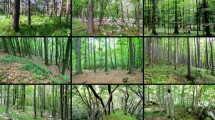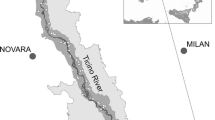Abstract
We investigated the ecological behaviour (the response to environmental factors in the field, synonymous to the term realized niche) of four closely related species pairs (Melica nutans, M. uniflora; Primula veris, P. elatior; Veronica chamaedrys, V. montana; Viola riviniana, V. reichenbachiana) across a transect from northern Central to North Europe. The second-mentioned species of each pair is confined in its geographical distribution to the southern parts of the studied transect. Sample plot data of deciduous forests were compiled from (1) Germany, S Niedersachsen, (2) Germany, northern Schleswig-Holstein, (3) Denmark, and (4) Boreo-nemoral Sweden. We compared the ecological optima and amplitudes of the response curves of species along the gradients for moisture, pH and nitrogen by means of phytosociological data, detrended correspondence analysis (DCA) and Ellenberg indicator values. pH measurements from Sweden were significantly correlated with the corresponding DCA sample plot scores and the plot averages of the Ellenberg values for reaction (pH).
In accordance with our main hypothesis, the wide range species appeared to have broader ecological amplitudes on the northern margins of their distributional ranges, especially in Boreo-nemoral Sweden, than in the southern parts of the study area. Our findings are in contrast to theories claiming a reduced niche breadth of range-margin populations of species compared to range-centre populations. The shifts in ecological behaviour were particularly obvious with respect to soil acidity. We believe that these shifts are caused by changes in the competitive relationships between the species: in the north, the total pool of species in deciduous forests is comparatively small. The low species richness is likely to lead to reduced competition and to an expansion of the ecological amplitude, known as competitive release.
Similar content being viewed by others
References
Begon M., Harper J.L. &Townsend C.R. (1990):Ecology. Individuals, populations and communities. Blackwell Scientific Publications, Cambridge.
Brown J.H. (1984): On the relationship between abundance and distribution of species.Amer. Naturalist 124: 255–279.
Brussard P.F. (1984): Geographic patterns and environmental gradients; the central-marginal model inDrosophila revisited.Annual Rev. Ecol. Syst. 15: 25–64.
Clausen J., Eeck D.D. &Hiesey W.M. (1940):Experimental studies on the nature of species. I. Effects of varied environments on western North American plants. Publication 520, Carnegie Institution of Washington, Washington.
Diekmann M. (1994a): Deciduous forest vegetation in Boreo-nemoral Scandinavia.Acta Phytogeogr. Suec. 80: 1–112.
Diekmann M. (1994b): En jämförande studie av nordisk backängsvegetation (Thermophilous forest edge vegetation in northern Europe).Svensk Bot. Tidskr. 88: 227–236.
Diekmann M. (1995): Use and improvement of Ellenberg’s indicator values in deciduous forests of the Boreo-nemoral zone in Sweden.Ecography 18: 178–189.
Diekmann M. &Dupré C. (1997): Acidification and eutrophication of deciduous forests in northwestern Germany demonstrated by indicator species analysis.J. Veg. Sci. 8: 855–864.
Diekmann M. &Falkengren-Grerup U. (1998): A new species index for forest vascular plants: development of functional indices based on mineralization rates of various forms of nitrogen.J. Ecol. 86: 269–283.
Dierschke H. (1994):Pflanzensoziologie. Verlag Eugen Ulmer, Stuttgart.
Eilertsen O., Økland R.H., Økland T. &Pedersen O. (1990): Data manipulation and gradient length estimation in DCA ordination.J. Veg. Sci. 1: 261–270.
Ellenberg H. (1996):Vegetation Mitteleuropas mit den Alpen in ökologischer Sicht. Ed. 5. Verlag Eugen Ulmer, Stuttgart.
Ellenberg H., Weber H.E., Düll R., Wirth V., Werner W. &Paulissen D. (1991): Zeigerwerte von Pflanzen in Mitteleuropa.Scripta Geobot. 18: 1–248.
Förster M. (1981): Waldgesellschaften der Bückeberge.Tuexenia 1: 213–231.
Garbutt K. &Zangerl A.R. (1983): Application of genotype-environment interaction analysis to niche quantification.Ecology 64: 1292–1296.
Gustafsson L. (1994): A comparison of biological characteristics and distribution between Swedish threatened and non-threatened forest vascular plants.Ecography 17: 39–49.
Haerdtle W. (1995): Vegetation und Standort der Laubwaldgesellschaften (Querco-Fagetea) im nördlichen Schleswig-Holstein.Mitt. Arbeitsgem. Geobot. Schleswig-Holstein & Hamburg 48: 1–441.
Hill M.O. &Carey P.D. (1997): Prediction of yield in the Rothamsted Park Grass Experiment by Ellenberg indicator numbers.J. Veg. Sci. 8: 579–586.
Hofmeister H. (1990): Die Waldgesellschaften des Hildesheimer Waldes.Tuexenia 10: 443–473.
Hutchinson G.E. (1978):An introduction to population ecology. Yale University Press, New Haven.
Jongman R.H.G., ter Braak C.F.R. &van Tongeren O.F.R. (eds.) (1987):Data analysis in community and landscape ecology. PUDOC, Wageningen.
Kowarik I. &Seidling W. (1989): Zeigerwertberechnungen nach Ellenberg — zu Problemen und Einschränkungen einer sinnvollen Methode.Landschaft Stadt 21: 132–143.
Kruse S. (1986): Laubwald-Gesellschaften im Innerste-Bergland.Tuexenia 6: 271–298.
Lötschert W. (1959): Kalkpflanzen auf saurem Untergrund. Ein Beitrag zur Frage der relativen Standortkonstanz.Flora 147: 417–428.
Minchin P. (1987): An evaluation of the relative robustness of techniques for ecological ordination.Vegetatio 69: 89–107.
Oberdorfer E. (1983):Pflanzensoziologische Exkursionsflora. Ed. 5. Verlag Eugen Ulmer, Stuttgart.
Økland R.H. (1990): Vegetation ecology: theory, methods and applications with reference to Fennoscandia.Sommerfeltia Suppl. 1: 1–233.
Parrish J.A.D. &Bazzaz F.A. (1985): Ontogenetic niche shifts in old-field annuals.Ecology 66: 1296–1302.
Passarge H. (1958): Vergleichende Betrachtungen über das soziologische Verhalten einiger Waldpflanzen.Arch. Forstwesen 7: 302–315.
Persson S. (1981): Ecological indicator values as an aid in the interpretation of ordination diagrams.J. Ecol. 69: 71–84.
Roedel H. (1970):Waldgesellschaften der Sieben Berge bei Alfeld und ihre Ersatzgesellschaften. Verlag J. Cramer, Lehre.
Sjörs H. (1967):Nordisk växtgeografi (Nordic plant geography). Ed. 2. Svenska Bokförlaget Bonniers, Stockholm.
ter Braak C.J.F. (1987):CANOCO — a Fortran program for canonical community ordination by (partial) (detrended) (canonical) correspondence analysis, principal component analysis and redundancy analysis (version 2.1). Agricultural Mathematics Group, Wageningen.
ter Braak C.J.F. &Gremmen N.J.M. (1987): Ecological amplitudes of plant species and the internal consistency of Ellenberg’s indicator values for moisture.Vegetatio 69: 79–87.
Thompson K., Hodgson J.G., Grime J.P., Rorison I.H., Band S.R. &Spencer R.E. (1993): Ellenberg numbers revisited.Phytocoenologia 23: 277–289.
Turesson G. (1922): The species and the variety as ecological units.Hereditas 3: 100–113.
van Valen L. (1965): Morphological variation and width of ecological niche.Amer. Naturalist 99: 377–390.
Walter H. &Walter E. (1953): Einige allgemeine Ergebnisse unserer Forschungsreise nach Südwestafrika 1952/53: Das Gesetz der relativen Standortskonstanz; das Wesen der Pflanzengemeinschaften.Ber. Deutsch. Bot. Ges. 66: 227–235.
Whittaker R.H. (1956): Vegetation of the Great Smoky Mountains.Ecol. Monogr. 26: 1–80.
Wilson M.V. &Mohler C.L. (1983): Measuring compositional change along gradients.Vegetatio 54: 129–141.
Author information
Authors and Affiliations
Corresponding author
Rights and permissions
About this article
Cite this article
Diekmann, M., Lawesson, J.E. Shifts in ecological behaviour of herbaceous forest species along a transect from northern central to North Europe. Folia Geobot 34, 127–141 (1999). https://doi.org/10.1007/BF02803080
Issue Date:
DOI: https://doi.org/10.1007/BF02803080




